The nation’s celebration of Black History Month is the perfect time to remember and celebrate those individuals who bore their trials and stations in life with dignity and courage while looking for ways to make changes in the world. Their personal journeys may remind readers of similar journeys for equality in making sure that opportunities for better lives exist for everyone. Inspired by these journeys, several youth build upon what others have left behind. As Charlayne Hunter-Gault writes in To the Mountain Top: My Journey through the Civil Rights Movement (2014), “Barack Obama does indeed stand on the shoulders of the giants—thousands of determined men, women, and young people who blazed a trail for him, just as our generation stood on the shoulders of the giants who, from the day they were brought to these shores in chains, never accepted the denial of their full humanity, freedom, justice, and rights” (p. 5).
This week’s column captures snapshots of ten such people, each telling their stories from different stations and times, but all of these narratives are reminders of human journeys. These reviews, written by members of the International Reading Association’s Children’s Literature and Reading Special Interest Group (CL/R SIG), salute the human spirit and the courage in these stories.
Grades K–3
Dempsey, Kristy. (2014). A dance like starlight: One ballerina’s dream. Illus. by Floyd Cooper. New York, NY: Philomel Books.
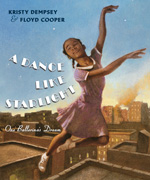 An old adage tells us that if we wish upon a star, our dreams may come true. But, what if no stars can be found in the sky? One little African-American girl living in 1960s New York City searches for stars night after night, but none can be found. She dreams of one day wearing the ballet costumes, twirling, swinging, swaying onstage in front of the crowd. Though she finds no stars in the New York City skyline, she is found by the Ballet Master of the ballet school. Thanks to the master, the young girl joins dance lessons every day, although she cannot perform with the White girls onstage. A visit to the Metropolitan Opera House and seeing the performance of Miss Janet Collins, the first African American performing there under a contract with Metropolitan Opera undoubtedly plants a seed of hope for the little girl to dream of becoming a ballerina. The illustrator’s use of pink and brown colors as well as the contrast effect between yellow and brown reinforces the dream and the hope of this young girl whose facial expressions are pictured vividly and realistically.
An old adage tells us that if we wish upon a star, our dreams may come true. But, what if no stars can be found in the sky? One little African-American girl living in 1960s New York City searches for stars night after night, but none can be found. She dreams of one day wearing the ballet costumes, twirling, swinging, swaying onstage in front of the crowd. Though she finds no stars in the New York City skyline, she is found by the Ballet Master of the ballet school. Thanks to the master, the young girl joins dance lessons every day, although she cannot perform with the White girls onstage. A visit to the Metropolitan Opera House and seeing the performance of Miss Janet Collins, the first African American performing there under a contract with Metropolitan Opera undoubtedly plants a seed of hope for the little girl to dream of becoming a ballerina. The illustrator’s use of pink and brown colors as well as the contrast effect between yellow and brown reinforces the dream and the hope of this young girl whose facial expressions are pictured vividly and realistically.
- Ying-Hsuan Lee, Washington State University Pullman
Woelfle, Gretchen. (2014). Mumbet’s Declaration of Independence. Illus. by Alix Delinois. Minneapolis, MN: Carolrhoda Books.
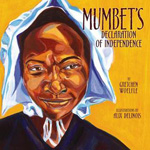 Mumbet, a slave in Massachusetts, did not even know her real name. She and her daughter Lizzy were owned by Mr. and Mrs. Ashley in Berkshire County. He also owned iron mine, a forge, a sawmill, a gristmill, a general store, and three thousand acres of farm and woodland. Mumbet longed to be free, while Mrs. Ashley made Mumbet’s life miserable, calling her spiteful names. One day, when she served the men who are writing the freedom charter, she heard words that set her heart soaring. But “All men are born free and equal” did not seem to include her. Eventually, though, Mumbet does find a way to her freedom. Simple and elegant narration coupled with bold illustration will capture the hearts of the readers who can learn more about Mumbet at www.mumbet.com. This is an excellent book for any classroom or school library.
Mumbet, a slave in Massachusetts, did not even know her real name. She and her daughter Lizzy were owned by Mr. and Mrs. Ashley in Berkshire County. He also owned iron mine, a forge, a sawmill, a gristmill, a general store, and three thousand acres of farm and woodland. Mumbet longed to be free, while Mrs. Ashley made Mumbet’s life miserable, calling her spiteful names. One day, when she served the men who are writing the freedom charter, she heard words that set her heart soaring. But “All men are born free and equal” did not seem to include her. Eventually, though, Mumbet does find a way to her freedom. Simple and elegant narration coupled with bold illustration will capture the hearts of the readers who can learn more about Mumbet at www.mumbet.com. This is an excellent book for any classroom or school library.
- Rani Iyer, Washington State University Pullman
Grades 4–6
Higgins, Nadia. (2014). The split history of the Civil Rights Movement: A perspectives flip book. North Mankato, MN: Compass Point Books.
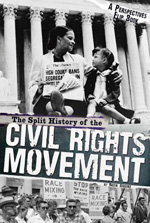 Emmett Till was beaten to death after allegedly flirting with a White cashier; Rosa Parks refused to give up her seat for Whites and was arrested; nine Black teenagers from Little Rock, Arkansas—also known as the Little Rock Nine—were escorted to attend an all-White high school while onlookers yelled and spat upon them; four Black college students sat at a Whites-Only lunch counter, which gave rise a series of protests. All of these incidents happened during the 1950s and 1960s when African Americans in the South wanted to stop segregation. From nonviolence to violence, from street and school to jail, and from children to adults, African Americans devoted themselves to a meaningful movement that offered a brighter future for their children. After learning about the civil rights movement from the activists’ perspective in this book, readers can flip the book to read the perspective of segregationists. The book offers stories about Ku Klux Klan rallies and information about the social, political, and economic motives behind the movement. This book surely provides a succinct but rich accounting of the history of Civil Right Movement.
Emmett Till was beaten to death after allegedly flirting with a White cashier; Rosa Parks refused to give up her seat for Whites and was arrested; nine Black teenagers from Little Rock, Arkansas—also known as the Little Rock Nine—were escorted to attend an all-White high school while onlookers yelled and spat upon them; four Black college students sat at a Whites-Only lunch counter, which gave rise a series of protests. All of these incidents happened during the 1950s and 1960s when African Americans in the South wanted to stop segregation. From nonviolence to violence, from street and school to jail, and from children to adults, African Americans devoted themselves to a meaningful movement that offered a brighter future for their children. After learning about the civil rights movement from the activists’ perspective in this book, readers can flip the book to read the perspective of segregationists. The book offers stories about Ku Klux Klan rallies and information about the social, political, and economic motives behind the movement. This book surely provides a succinct but rich accounting of the history of Civil Right Movement.
- Ying-Hsuan Lee, Washington State University Pullman
Kanefield, Teri. (2014). The girl from the tar paper school: Barbara Rose Johns and the advent of the Civil Rights Movement. New York, NY: Abrams Books for Young Readers.
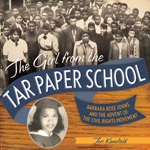 Picture this: A classroom built from wood, a heavy tar paper roof, umbrellas, buckets, and shivering students with heavy winter clothes. This image is not something imaginary; it is the classroom of the Robert R. Moton High School, which Barbara Rose Johns attended in 1950. It was the time when school segregation existed, when White students attended schools with superior modern facilities and Black students often learned in tar paper shacks. Having had enough of learning in such an environment, Barbara Johns, then a 16-year-old, secretly planned a peaceful strike in 1951 to make inequality have no place in education. With the support of local churches, she did not fight alone, for similar movements against inequality also happened in Kansas, South Carolina, Delaware, and Washington, D.C. It was not until Johns was in college that the Supreme Court declared that school segregation was unconstitutional. This book provides a mix of biography and historical archives, which invites readers to learn about one of the pioneers in Civil Rights Movements as well as understand how a small, simple wish can make a significant change in society.
Picture this: A classroom built from wood, a heavy tar paper roof, umbrellas, buckets, and shivering students with heavy winter clothes. This image is not something imaginary; it is the classroom of the Robert R. Moton High School, which Barbara Rose Johns attended in 1950. It was the time when school segregation existed, when White students attended schools with superior modern facilities and Black students often learned in tar paper shacks. Having had enough of learning in such an environment, Barbara Johns, then a 16-year-old, secretly planned a peaceful strike in 1951 to make inequality have no place in education. With the support of local churches, she did not fight alone, for similar movements against inequality also happened in Kansas, South Carolina, Delaware, and Washington, D.C. It was not until Johns was in college that the Supreme Court declared that school segregation was unconstitutional. This book provides a mix of biography and historical archives, which invites readers to learn about one of the pioneers in Civil Rights Movements as well as understand how a small, simple wish can make a significant change in society.
- Ying-Hsuan Lee, Washington State University Pullman
Shabazz, Ilyasah. (2014). Malcolm Little: The boy who grew up to become Malcom X. Illus. by Ag Ford. New York, NY: Athenum.
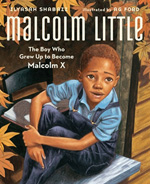 El-Hajj Malik El-Shabazz, better known as. Malcolm X, had a tumultuous childhood. His lessons in faith and courage were earned from his parents early in life. When his father purchased six acres of land in Lansing, Michigan, Malcolm watched his father build the house by himself. Malcolm cherished his father’s optimism and faith. His mother home-schooled the kids and taught them all they knew. But his carefree childhood ended when his father was lynched by the KKK, leaving his mother to manage the farm, children, and household. Soon, the local officials separated the children from Louise, for reasons nobody would explain. All the challenges faced by the boy who grew up to become Malcolm X are narrated with his daughter’s deep insider knowledge to present the real Malcolm X to a young audience. There are plenty of online resources available to bring his story to today’s young readers, including this example of Malcolm talking about slavery.
El-Hajj Malik El-Shabazz, better known as. Malcolm X, had a tumultuous childhood. His lessons in faith and courage were earned from his parents early in life. When his father purchased six acres of land in Lansing, Michigan, Malcolm watched his father build the house by himself. Malcolm cherished his father’s optimism and faith. His mother home-schooled the kids and taught them all they knew. But his carefree childhood ended when his father was lynched by the KKK, leaving his mother to manage the farm, children, and household. Soon, the local officials separated the children from Louise, for reasons nobody would explain. All the challenges faced by the boy who grew up to become Malcolm X are narrated with his daughter’s deep insider knowledge to present the real Malcolm X to a young audience. There are plenty of online resources available to bring his story to today’s young readers, including this example of Malcolm talking about slavery.
- Rani Iyer, Washington State University Pullman
Grades 7–8
Bolden, Tonya. (2014). Searching for Sarah Rector: The richest Black girl in America. New York, NY: Abrams Books for Young Readers.
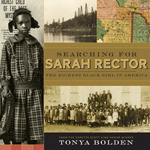 This excellent nonfiction narrative looks at the mystery of wealthy Sarah Rector. Born in 1902 as a freedwoman in the Creek, Indian Territory, Sarah was not destined for any great fortune or wealth. Her parents were farmers and grew corn and cotton. The family acquired a land allotment for the members of the Creek Nation, but the land was rough, full of rocks, and required payment of about $30 in taxes. Fed up with the useless land, Sarah’s father leased the land to an oil drilling company. By 1913, the well on Sarah’s land began to yield dividends. Newspapers estimated the output to be about 105,000 gallons a day and predicted that Sarah would soon become a “Plute,” slang for plutocrat or a very wealthy person. When a child went from poor to plute, the courts insisted on appointing a guardian for managing the minor’s affairs. The story pieces together the oil boom and what it meant to people around the country. The life of Sarah Rector has often been compared to the story of Cinderella. Learn more in this excellent author interview regarding the project.
This excellent nonfiction narrative looks at the mystery of wealthy Sarah Rector. Born in 1902 as a freedwoman in the Creek, Indian Territory, Sarah was not destined for any great fortune or wealth. Her parents were farmers and grew corn and cotton. The family acquired a land allotment for the members of the Creek Nation, but the land was rough, full of rocks, and required payment of about $30 in taxes. Fed up with the useless land, Sarah’s father leased the land to an oil drilling company. By 1913, the well on Sarah’s land began to yield dividends. Newspapers estimated the output to be about 105,000 gallons a day and predicted that Sarah would soon become a “Plute,” slang for plutocrat or a very wealthy person. When a child went from poor to plute, the courts insisted on appointing a guardian for managing the minor’s affairs. The story pieces together the oil boom and what it meant to people around the country. The life of Sarah Rector has often been compared to the story of Cinderella. Learn more in this excellent author interview regarding the project.
- Rani Iyer, Washington State University Pullman
Moses, Shelia. (2014). The sittin’ up. New York, NY: Putnam & Sons.
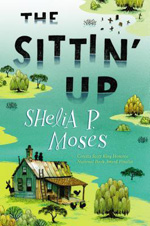 The story begins in the summer of 1940 when the very last slave man, Mr. Bro. Wiley has died of old age. He had lived with twelve-year-old Bean for many years now, and was like an adopted grandfather to him. The entire family grieves about the death, and the community mourns. Bean, certain that his grandfather deserves special respect for being the last slave man alive, writes to the President with the news of his death. Besides grief, the death also brings responsibilities for Bean. He now needs to join his very first sittin’ up—a wake for the dead—with all the adults. He and Pole, his best friend, are both sad and excited about it the same. The setting and characters in the book show the interconnectedness of the people with the land and with each other. In the end, it is not the life of a single person but the community that is skillfully presented. This is a portrait of a close-knit community where everyone knows each other very well, the good and bad. The sense of community leaves readers enrapt and provides an excellent context for the readers to explore their feelings of belonging to the community. The book is also rich in language with melodic dialect and a rhythm that is out of synch with the modern patterns of speech. Learn more in this interview with the author.
The story begins in the summer of 1940 when the very last slave man, Mr. Bro. Wiley has died of old age. He had lived with twelve-year-old Bean for many years now, and was like an adopted grandfather to him. The entire family grieves about the death, and the community mourns. Bean, certain that his grandfather deserves special respect for being the last slave man alive, writes to the President with the news of his death. Besides grief, the death also brings responsibilities for Bean. He now needs to join his very first sittin’ up—a wake for the dead—with all the adults. He and Pole, his best friend, are both sad and excited about it the same. The setting and characters in the book show the interconnectedness of the people with the land and with each other. In the end, it is not the life of a single person but the community that is skillfully presented. This is a portrait of a close-knit community where everyone knows each other very well, the good and bad. The sense of community leaves readers enrapt and provides an excellent context for the readers to explore their feelings of belonging to the community. The book is also rich in language with melodic dialect and a rhythm that is out of synch with the modern patterns of speech. Learn more in this interview with the author.
- Rani Iyer, Washington State University Pullman
Woods, Brenda. (2014). The blossoming universe of Violet Diamond. New York, NY: Nancy Paulsen Books.
 11-year-old Violet Diamond is very sensitive about her biracial identity—her mom being White, and her dad Black. Since her dad died two months before she was born, the brown-eyed and brown-haired girl spends most of her life with her maternal side of the family and lives in a White neighborhood. Although Violet is close to her family, and her friends accept her, sometimes she feels that she is “a single fallen brown leaf atop a blanket of fresh snow” (p. 18). In order to know more about her Black side of the family, Violet determines to meet her paternal grandmother, Bibi, whom she has never met before. Violet’s first meeting with Bibi is filled with tension and not as happy as she expects. However, as she spends more time with Bibi, both of them become closer. This heartwarming story shows a young girl’s exploration of her identity and family history as well as allowing readers insight into the idea that the concept of family goes beyond race.
11-year-old Violet Diamond is very sensitive about her biracial identity—her mom being White, and her dad Black. Since her dad died two months before she was born, the brown-eyed and brown-haired girl spends most of her life with her maternal side of the family and lives in a White neighborhood. Although Violet is close to her family, and her friends accept her, sometimes she feels that she is “a single fallen brown leaf atop a blanket of fresh snow” (p. 18). In order to know more about her Black side of the family, Violet determines to meet her paternal grandmother, Bibi, whom she has never met before. Violet’s first meeting with Bibi is filled with tension and not as happy as she expects. However, as she spends more time with Bibi, both of them become closer. This heartwarming story shows a young girl’s exploration of her identity and family history as well as allowing readers insight into the idea that the concept of family goes beyond race.
- Ying-Hsuan Lee, Washington State University Pullman
Grades 9–12
Hunter-Gault, Charlayne. (2014). To the mountain top: My journey through the Civil Rights Movement. Reprint Edition. New York, NY: Square Fish.
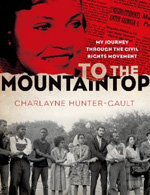 The author, who grew up as a high school student in segregated Atlanta, describes how every aspect of her daily life was controlled by segregation. The emotionally enriched, engaging narrative will shock some teen readers. Told in engaging tone and voice, the historical memoir illustrates the context of the Civil Rights Movement from the perspective of equal education. Educated in a series of second-class schools, the author longed for equal treatment. As her educational possibilities opened up once the idea of separate but equal institutions was challenged, Hunter-Gault attended the University of Georgia where she faced systematic harassment and threats. Her personal narrative coupled with information about various civil rights groups such as NAACP, SCLC, and SNCC shows that change came from many different directions. The book has excellent timelines that can be used both by students and teachers.
The author, who grew up as a high school student in segregated Atlanta, describes how every aspect of her daily life was controlled by segregation. The emotionally enriched, engaging narrative will shock some teen readers. Told in engaging tone and voice, the historical memoir illustrates the context of the Civil Rights Movement from the perspective of equal education. Educated in a series of second-class schools, the author longed for equal treatment. As her educational possibilities opened up once the idea of separate but equal institutions was challenged, Hunter-Gault attended the University of Georgia where she faced systematic harassment and threats. Her personal narrative coupled with information about various civil rights groups such as NAACP, SCLC, and SNCC shows that change came from many different directions. The book has excellent timelines that can be used both by students and teachers.
- Rani Iyer, Washington State University Pullman
These reviews are submitted by members of the International Reading Association's Children's Literature and Reading Special Interest Group (CL/R SIG) and are published weekly on Reading Today Online.
The CL/R SIG is accepting submissions to the fall 2014 edition of their journal, The Dragon Lode, through April 15, 2014. There is an open theme, and they invite manuscripts that explore contemporary issues and questions, genre study, literary theory, and research related to children's literature and reading. Manuscripts should be no longer than 20 double-spaced, typed pages. Use APA (6th edition) formatting. Author's name, affiliation, mailing address, telephone and fax numbers, and e-mail address should be on a separate cover page. Photos and illustrations should be sent as a separate jpeg file. Any reference to the author that would enable the reviewer to know the author's identity should not appear in the manuscript. Submit all manuscripts to: Dr. Ruth McKoy Lowery, Co-editor.